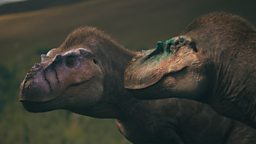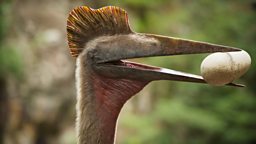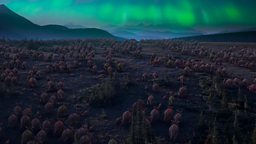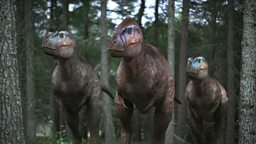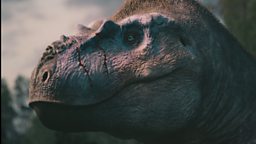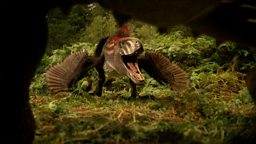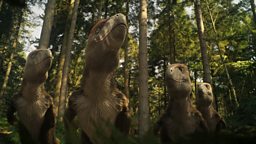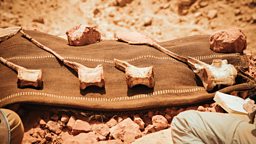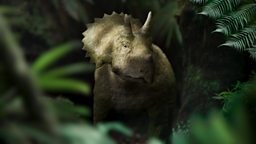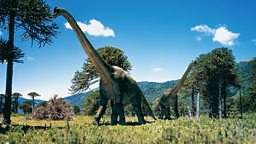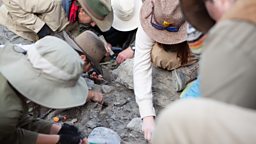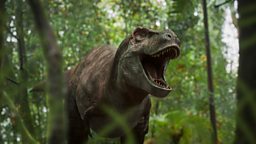What modern animals can tell us about dinosaurs
Series assistant producer Sam Wigfield interviews palaeontologist Mark Powers
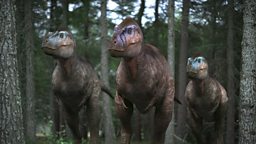
Across the series, the extraordinary behaviour of dinosaurs is brought to life through cutting edge VFX. The scientific research supporting our understanding and computer generated creation of these dinosaurs was often found in the ground, but a surprising amount of inspiration was drawn from the modern natural world. Scientists often look to animals living today to understand those of the past. Considering how these prehistoric animals may have lived, rather than simply how they died, completely alters our understanding of this ancient world. So how did the Walking with Dinosaurs team start the process of bringing the Albertosaurus characters to life?
Albertosaurus share many similarities in appearance with their famous cousin, Tyrannosaurus rexMark Powers
To begin with, we have to look for clues within the anatomy of our dinosaur, as palaeontologist Mark Powers explains:
“Albertosaurus share many similarities in appearance with their famous cousin, Tyrannosaurus rex, though they roamed North America a few million years before. Their tyrannosaur frame made them the largest predators known during the time of their reign (71-69 million years ago). Adult Albertosaurus had deep jaws which would have been deadly efficient in grabbing and subduing prey species.”
Whilst adult Albertosaurus had a bulky carnivorous frame, there were noticeable differences in the anatomy of younger Albertosaurus.
“Up until their late teenage years, Albertosaurus retained long hind-limbs that allowed them to be more mobile than some of their close kin. Although they were lighter and faster than some of their relatives, adult Albertosaurus were still too large to reach the speeds of the teenagers.”

This difference in body structure, between fast juveniles and the slower, stronger adults could have led them to live separate lives. Yet a remarkable discovery changed our understanding of how predators could have lived alongside each other, and even the techniques predators used to hunt their prey. Mark Powers uses the following comparison:
Male lions serve much the same role in many lion hunts on the Savannah.Mark Powers
“Although other tyrannosaurs have been found in small groups of two to five individuals (Daspletosaurus, Teratophoneus, and Tyrannosaurus), Albertosaurus has been found in a group as large as 28 individuals! Whether these were all part of one group or several that gathered together is unknown, but the fact that this many individuals were so close together at the time of their death demonstrates a clear tolerance for each other.
Nearby, an abundance of large bonebeds of Edmontosaurus means it is possible that the large group of Albertosaurus was gathered in preparation for a herd of Edmontosaurus roaming through. Albertosaurus may have achieved an ingenious hunting method to capitalise on the differences between young and old individuals. By dividing the labour, the youthful Albertosaurus would run into the herd to disrupt their organisation, much like modern lions or African wild dogs do today.”
Finding animals in the modern world which have analogous group structures can offer a deeper insight into prehistoric behaviour
“This level of coordination in hunts is unknown for dinosaurs. However, the frequency of tyrannosaurs found in groups suggests group hunting may have been a norm. The exceptionally large group of Albertosaurus would have required further coordination and shows a clear sociality in these iconic predatory animals. Once an individual was isolated, it would be vulnerable to the powerful adults coming in to finish the job with a powerful bite. Male lions serve much the same role in many lion hunts on the Savannah.”

As the largest predator in the landscape, Albertosaurus should have had nothing to fear, and yet fossil evidence suggests the danger may have been closer to home than expected.
Albertosaurus would engage in aggressive behaviour towards one anotherMark Powers
“Like other tyrannosaurs, Albertosaurus would engage in aggressive behaviour towards one another, evidenced by healed scarring on bones of the face. The wounds inflicted were non-fatal and show that this behaviour would likely have been a regular part of life to establish dominance over one another for access to food or mates. We see the same behaviour in many modern animals, but this is the most similar to the pattern seen in modern crocodilians. These mostly occur in males for modern crocodilians, but some females partake as well, showing it is not unique to one sex. Because not all specimens of Albertosaurus have evidence of this face biting, it could be hypothesised that it was a sex-specific behaviour. However, which sex is unknown for Albertosaurus, so it could be that females were the larger, more aggressive ones forming a functional matriarch. Matriarchs are observed in large animals today, such as elephants and killer whales. Killer whales are also very social hunters that may reflect similar familial structures to Albertosaurus, but differ in that they live in aquatic environments.”
Working closely with world leading experts the Walking with Dinosaurs team featured behaviour which was not only supported by the fossil record but drew on animal behaviours seen in the modern world today. Looking to modern ancestors of dinosaurs the team and experts developed sequences showcasing behaviours which may have existed for millions of years. The production team at the ÃÛÑ¿´«Ã½ Studios science unit making the series knew that ultimately the very best stories are true, and following the science can lead us to stranger, and yet more believable, places than fiction.
